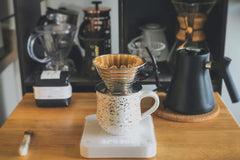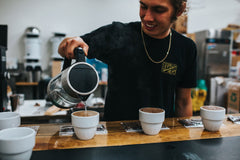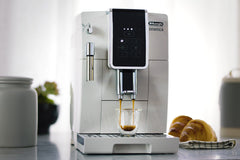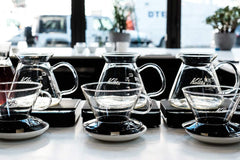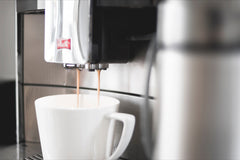
If you’re reading this right now, you’ve probably heard the term “specialty coffee” before. Or maybe even tasted it.
See the thing is, coffee companies and producers have to meet a lot of criteria to earn that “specialty” title, and today we’re going to find out why. All that is to say that you’ve come to the right place!
Sit tight, get comfy, and grab a cup of coffee. But not just any kind, this time, it’ll be specialty coffee. Here we go:
Specialty Coffee Overview
Contrary to what you think you know, coffee is not just coffee. It’s not all grown the same way neither is it roasted or brewed or even drank the same way. And specialty coffee has been the one making the newest waves.
Without further ado and some *drum roll* please….here’s the definition:
Specialty coffee is coffee that focuses on quality, consistency, sourcing and its transparency, roasting and brewing methods of every single coffee bean. It’s a more intimate and beautiful relationship with our favorite drink.
Now let’s break that down a bit more and understand what specialty coffee looks like at every stage.
Specialty Coffee Sourcing and Origins
Now let’s imagine, as nightmarish as it may seem, that you are buying the standard coffee from your local grocer. Folgers, Maxwell House, or whatever else they have in stock.
Do you know exactly where that coffee comes from? If you have some grocery store coffee at home, go ahead and look.
No worries, I’ll wait…
Found anything? Chances are… no! And it’s not because you couldn’t read it on the container either, it’s just… not available to you. Which brings us to…
Point #1
Specialty coffee understands that where a coffee comes from, how it was sourced and how it was processed are VERY important to the individuality of each coffee bean.
There are two common varieties of specialty coffee beans you should care about and will normally come across. These two are Arabica and Robusta. They are very different in taste, origin, and how they are grown.
Arabica is the one you will run into most of the time and so it will be our focus here.
Now that we know the types, let’s dig in a little deeper on why the coffee’s origin matters greatly. Here are three important question you should always have answers to:
1. Where was your coffee grown?
Coffee grows pretty much all over the equatorial zone. This is also tied to different altitude levels or meters above sea level (MASL) that coffee can grow in.
You might not realize it, but where coffee grows has a significant difference in its tasting notes, scent, how you roast it, how you brew it, and all its other qualities.
Your coffee kind of loses all of its individuality when you get sold an “original blend” from a mysterious land.
2. How was your coffee processed?
When a coffee tree is harvested, the beans are actually in this cherry-like casing. They are called coffee cherries, or just cherries or berries, or whatever you really want to call them.
This means that the coffee beans are actually inside these cherries and to get to it the coffee has to be processed.

For now, I’ll mention two processing methods, natural and washed.
Natural Processing:
After harvest, the cherries are allowed to ferment before removing the cherry flesh/casing and separating the coffee beans.
During this fermentation period, the coffee absorbs some of the fruity flavors from the cherry and this is very clear in the taste. This is the original way of processing coffee and originated in Ethiopia.
Washed Processing:
Here the opposite happens.
The cherry is removed (washed) and then the beans are dried. You are trying to get the coffee’s unaltered flavors so fermentation is avoided and/or controlled.
As you can imagine, this requires a lot of water and it does produce high-quality coffee. So today this is the most used coffee processing method in the world.
3. How was your coffee sourced? Was it ethical?
You have probably heard of the terms Fair Trade, Direct Trade or Ethically Sourced. Like I mentioned earlier, specialty coffee keeps a closer working relationship with coffee producers. And this information is almost always shown on the packaging.
Traditionally, coffee goes through multiple stages from different buyers to get all the way to your cup. The alternative to this is to go direct and/or source through someone else who deals directly with the farmers.
Think about it this way: if there are multiple stages in coffee purchasing, every single person that sells the coffee is going to put a margin on it. This ends up hurting the person at the bottom, the farmer.
That’s why you have fair trade, which operates through a cooperative and serves as something like a union for farmers, protecting them and providing education and equipment.
Direct trade, as the name suggests is the roaster going directly to the farmer, building that relationship themselves and buying from them. This comes at a premium price, which again benefits the farmer. There is also semi-direct trade which just means roasters deal with another body or organization to bring their coffee and they themselves do the direct trade.
These are pretty important questions that you should have answers to about your coffee. Considering you probably drink it more than once a day, it makes it even more important. And specialty coffee is the answer to your questions.
The Art of Coffee Roasting
There are two cases here, mass consumption roasting and small batch roasting. Guess which one describes specialty coffee?

Small batch roasting and just coffee roasting, in general, has become a craft, an art, a beautiful intersection of science, love, and dedication.
Through small batch roasting, coffee roasters are able to test multiple roast profiles (another way of saying how much the coffee is roasted) and cup it many many many many times! This is essentially a really good quality control program.
I was recently speaking with a friend of mine, a Toronto-based coffee roaster, Felix at De Mello Palheta and he put it as, “sometimes it taking days to weeks and multiple roasts to figure out the right fit for the coffee.”
Now, that is dedication!
But most importantly, it is a deeper understanding that each coffee needs to be treated differently.
And guess what? This makes the coffee taste that much better. You know from the first sip that this is how coffee is supposed to be. This is what you should be drinking and what you should have been drinking.
The other side to roasting is how fast your coffee gets to you after roasting.
Ideally, coffee should be consumed after about 5 days of roasting. This allows the coffee to de-gas (this is that intense coffee smell you get when you buy fresh roast coffee) enough to drink.
After that, I would say within 30 days of the roasting your coffee should be really good. After that, it is inevitable, but your coffee will start to get stale.
This is why the date the coffee was roasted is such an important piece of information. It lets you know how fresh your coffee is. Specialty coffee is always stamped with the date of the roast. If you are buying coffee and there is no roast date to be found, then you can safely assume that it isn’t fresh.
Specialty coffee will take the guesswork out of this one for you.
Cultural Impact of Specialty Coffee
Admit it, your local specialty coffee shop is a little too serious about their coffee and it kind of looks like a hipster congregation. But there is no doubt they have better coffee than your local chain coffee shop.
Specialty coffee has brought along with it a new cultural coffee wave. The third wave coffee culture, artisan coffee, and even the “coffee like wine” wave. All of these are just side effects of specialty coffee and our recent realization of it.
However, some people are somewhat intimidated by this and often label it as “hipster coffee”, as if it is some far unknown thing that they are just not “cool” enough to enjoy or even appreciate.
This is a misconception.

Don’t be fooled by someone else’s passion and dedication to bring out the best in something. People have just started taking coffee seriously, much like chefs do with their ingredients. As they should.
If you are in the bigger cities (New York, LA, Toronto, Seattle, Montreal, Vancouver..take your pick). You’ll have probably noticed the amount of small, specialty and craft coffee shops popping up. It’s a beautiful thing because it means now we are getting more and more specialty coffee selections.
Similarly, roasteries (coffee roasters) have popped up everywhere and, honestly, I couldn’t be happier. This is allowing the world of specialty coffee to evolve and grow at a much faster rate. All it needed was participation.
Think of it this way, every one of these coffee roasters and shops is roasting and brewing the coffee in a unique way. This creates variety, it creates awareness, and, most importantly, some damn good coffee!
Which one is the best is for you to decide.
Specialty Coffee Brewing
This has probably got to be the most exciting part because this is where you get to taste the final result, yay!
There should be an equal amount of focus on how coffee is ground, extracted, brewed, and how all of this varies with each brewing method.

Slow Coffee Brewing
You have probably noticed many coffee brewers popping up (or they are just becoming more popular nowadays) and their point is to create slow and ritualistic brewing. In other words, they’re a way of manual brewing. Note that these mostly apply to pour-over style brewing.
The quality of coffee you get is similar to the difference between fast food and, well, slow food (think home-cooked meal). One is all about speed of delivery and the other is about quality.
Slow brewing coffee is the same.
You could get a Keurig to pull you up a cup faster than lightning, but would it taste the same? Probably not. Because sometimes coffee has to be carefully measured, ground and poured, hence the name slow brewing.
Measure Everything
If you want consistency, you have to measure consistently. This doesn’t only happen when brewing either, it’s all over the whole specialty coffee process.
In brewing, the most common way of measuring is looking at the weight of coffee and water, and the sizes and consistency of the ground coffee. This will help you calibrate and understand how each factor affects the taste of your coffee.
Here’s why this is important:
-
Determining your coffee to water ratio.
- Sometimes you can have a cup that is too concentrated or too weak. Knowing how much water you use fixes this.
-
Figuring out the right grind size for each brew.
- From personal experience, this has probably been the toughest. Different brewing methods will require different grind sizes. Experiment your grinds and never let go once you hit those sweet spots.
-
Perfecting the time in between pours.
- I normally use a stopwatch feature on my phone for this. Basically, coffee will go through different stages of extraction from the initial pour of the bloom stage. This helps you nail down the timings of each.
Luckily, there have been many apps and tools popping up recently that make measuring so much easier. Most notable is Acaia which has an app too. It does WONDERS in keeping track of your brewing and measuring everything related to it.
>> Check out our full review of the best kitchen scales
The Coffee Making Ritual
If you talk to most people that brew their own coffee using equipment like Chemex, Kalita Wave, AeroPress, Hario V60 or others, you’ll notice that they have some sort of a ritual.
It starts with first weighing out your coffee and then you develop a ratio of coffee to water that works for you (we at Nomad suggest a 1:16 ratio of water to coffee to start off).
Then, there is rinsing of filters and from there it varies from person to person.
Some will have different amounts of water that they pour and in specific rounds. If this sounds complicated, trust me it isn’t. It just all comes from realizing that a “one size fits all” kind of coffee brewing doesn’t work in every case and, most importantly, it probably doesn’t work for you.
One thing this reminds me of is the East African coffee ceremony. If you haven’t had it, do it! Now! It is almost part of everyday life for people in countries like Eritrea and Ethiopia.
The way it works is that the coffee is roasted, ground and brewed all in the same sitting. Every single step is rich with tradition, culture and the aroma of freshly roasted coffee. Once the coffee is ground it is boiled in a clay pot called a “jebena” and served in this small espresso cup sized “fenjals.”
It’s something that always brings people together and the whole process is done from start to finish with everyone sitting around. That’s why the word ceremony is the perfect way of describing it.
Now back to slow brewing rituals. Do it, enjoy it and share it! At times, it’s almost therapeutic, like a moment of “ahhh.”
Final Thoughts on Specialty Coffee
If you made it this far, then clearly you have enjoyed this piece.
I can talk to you about specialty coffee for hours and possibly days, but it is more fun when you discover it for yourself. There’s so much great quality coffee out there now, that settling for just the regular old cup of joe means you are missing out.
Specialty coffee is about exploration and experimentation to find what is best for you. So take this as your starting point.
Don’t start your coffee journey tomorrow. Don’t push it off any longer. Do it today.
If you don’t know where to get coffee, just head over to your local coffee roaster’s shop and pick up a freshly roasted batch. If that’s not possible or it just happens that your local coffee isn’t specialty, then order some online.
Be crafty, be a mad scientist, experiment and try out every single thing you can think of with your coffee.
Here are some things to get you started:
- 10 Commandments of Specialty Coffee
- Best Pour Over Coffee Brewer
- How to Make Pour Over Coffee at Home
-
The World Atlas of Coffee: From Beans to Brewing
If you loved this article as much as I loved writing it, do me a favor and like and/or share the post with your friends.
Happy brewing!


